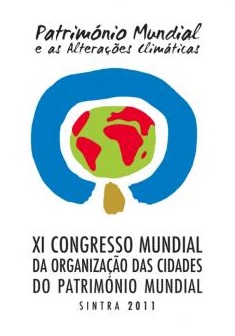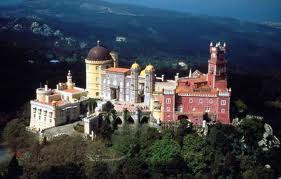XIth World Congress of the OWHC - Sintra 2011: World Heritage Cities and Climate Change
- Ayrıntılar
- Üst Kategori: ROOT

The World Congress of the OWHC is a unique forum - held every two years, it brings together politicians and professionals who are committed to the preservation of historic cities, particularly those inscribed on UNESCO’s World Heritage List. Since the first meeting in 1991, this event has enabled participants to discuss topics of common interest, to share experiences, and to learn about new strategies for meeting the challenges associated with the conservation and management of World Heritage Cities.
The theme of the XIth World Congress is World Heritage Cities and Climate Change.
World Heritage Cities are vibrant living environments with cultural heritage of outstanding universal value. In the face of climate change, however, World Heritage Cities are among the most vulnerable places on Earth to experience rapidly occurring changes.The site-specific nature of climate change impacts make World Heritage Cities ideal laboratories for monitoring changes and testing adaptation and mitigation measures to enhance their socio-economic well-being while ensuring the conservation of their heritage.
 City governments are at the heart of the action. Having conserved their rich heritage over time, World Heritage Cities hold the keys to understanding long-term evolution of a place from the past and on to the future.As guardians of the world’s heritage, World Heritage Cities face an additional challenge - any action taken at these iconic places can attract considerable attention and influence the adoption of good management practices elsewhere. This XIthWorld Congress aims to create a platform for dialogue and exchange of state-of-the-art knowledge on the issue of World Heritage Cities and Climate Change and its transfer into policy and action.
City governments are at the heart of the action. Having conserved their rich heritage over time, World Heritage Cities hold the keys to understanding long-term evolution of a place from the past and on to the future.As guardians of the world’s heritage, World Heritage Cities face an additional challenge - any action taken at these iconic places can attract considerable attention and influence the adoption of good management practices elsewhere. This XIthWorld Congress aims to create a platform for dialogue and exchange of state-of-the-art knowledge on the issue of World Heritage Cities and Climate Change and its transfer into policy and action.
To articulate the theme, the organizers of the XIthWorld Congress have developed a programme that includes four keynote presentations, several questions & answers sessions following each presentation, a panel discussion focusing on the adaptation and mitigation measures to be taken by historic cities, a poster session featuring case studies related to the Congress’ theme, and activities for a select group of journalists, who will contribute their views about the relations between heritage and climate change.
Any details can be found on the website: www.sintraovpm2011.com.
Call for Posters
During the World Congress a Poster Session will be organized to give participants the opportunity to share their experiences. Posters will be published in the conference pre-prints and exhibited during the entire duration of the Congress. The Poster Session will be officially opened in the afternoon of 23 November 2011 followed by presentations of each poster and time allocated for discussion with authors. A limited number of Posters may also be selected as “city snapshots” to complement the key-notes during the morning sessions of the scientific programme on 23 and 24 November 2011.
This Call addresses all those who are engaged in the conservation and management of a World Heritage City - public servants and administrators, specialized professionals, technical experts and scientists from various fields related to cultural and natural heritage on an interdisciplinary basis.
Posters should reflect on how a City addresses questions of climate change impacts, such as a city’s vulnerability to impacts, how it develops adaptation and/or mitigation measures in conceptual and action-oriented ways, how heritage and culture can be assets for risk management and climate change mitigation. In particular, case studies are encouraged that examine the rationale of choices made for a specific city illustrating how the City can be part of the solution by influencing both the causes and consequences of climate change and thus contributing to national and international strategies to prevent climate change impacts. The three pillars of sustainability, social, environmental and economic - complemented by the fourth “governance” pillar - should be taken into account. Some of the following points and questions may guide you in the choice of your contribution; they are examples and not exclusive:
Knowing and studying climate change impacts
- What do you know about climate change impacts on a/your city? What are the vulnerable elements of your World Heritage city and how do you assess and monitor them?
- Are there any studies on how historic urban fabric can provide an efficient, compatible and sustainable response to climate change issues and challenges?
- Do you monitor, and how, the links and impacts of greenhouse gas emissions, energy consumption, and energy efficiency measures on heritage conservation?
- Are there any socio-economic studies applying cost-benefit analysis to value the economic losses from climate change?
Creating policies and governance models
- How do you link conservation with the requirements of new directives, legislation, or regulation derived from the international and national treaties regarding climate change adaptation and mitigation?
- How much of the greening of the city can be considered compatible with the historic environment, which adaptation measures are acceptable for the historic building stock and the historic environment at large?
- How do you integrate policies and regulations on climate change and conservation of the historic environment intothe overall planning and management processes?
- Which policies and tools are still missing and need to be developed?
- What funding sources can be used?
Adapting to potential impacts
- Has your City developed an Adaptation Plan?
- How do you assess the City’s ability to adapt to anticipated changes in climate?
- How do you adapt the city to the already perceived impacts of climate change, such as extreme weather events, flooding etc?
Communicating and involving citizens
- How do you communicate climate change issues and its impacts to your citizens?
- How do you inform the public, property owners and other stakeholders about measures that have to be taken to adapt to and anticipate climate change impacts?
- How do you involve your citizens in the actions? How do you engage inhabitants, visitors and other stakeholders in proposing creative solutions?
Instructions for submitting abstracts:
The deadline for submission of abstracts for posters is 31 March 2011.
- Abstracts need to be 200 words maximum
- Text size needs to be 12 point Times New Roman, double-spaced.
- Abstracts should include the full name, affiliation, and contact details of all authors (if there is more than one author, please indicate who is the corresponding author), and clearly state how the theme of the congress will be addressed.
- Posters will be accepted only in English, French, Spanish or Portuguese.
- All proposals will be reviewed by the Congress’ Scientific Committee.
Authors will be informed of the acceptance of their poster no later than 31 May 2011.
Instructions for submitting posters:
Specific guidelines and an electronic layout template will be provided to the authors of accepted posters.
Posters should strive to be attractive and well organized. It is important that they are self-explanatory, that the text be minimal, and that mainly photographic images and graphics are used
The dimension of the poster shall not exceed 85 cm in width x 120 cm in height. Authors are asked to submit the poster in electronic version 4 weeks before the Congress in order to allow for timely printing by the host city. Short videos of 2-3 minutes will be accepted as well.
Please submit your poster abstract via email to:
Ms. Kerstin Manz
Bu e-Posta adresi istenmeyen posta engelleyicileri tarafından korunuyor. Görüntülemek için JavaScript etkinleştirilmelidir.
SINTRA
Sintra is situated in the north side of Serra of Sintra and offers numerous sights to visitors. Even the Portuguese kings had their summer residence there. You can find enchanted villas, gardens with rampant plants, fairy-tale castles in the middle of green mountain slopes. This recreational area isn't only popular for tourists but also for inhabitants of Lisbon. Long streams of cars from Lisbon are formed particularly on weekends. Hans Christian Andersen described Sintra as "the most beautiful place of Portugal".
The old town of Sintra is dominated by the Palácio Nacional de Sintra, which can be seen from far away at its gigantic conical chimneys. In the course of the centuries this popular summer residence of the kings got several rebuilding and modifications, so that today it consists of a mixture of different architectural styles. The Sala dos Brasões and Sala dos Cisnes are particularly remarkable.
Wander through the lanes of the place and have a look in the souvenir shops. Send a postcard from the beautiful tiled post-office.









